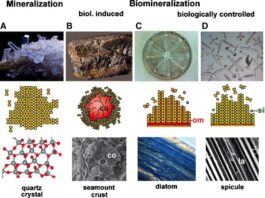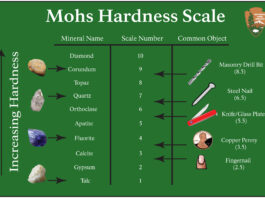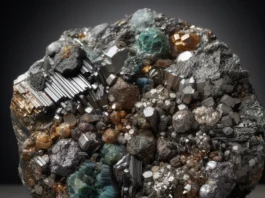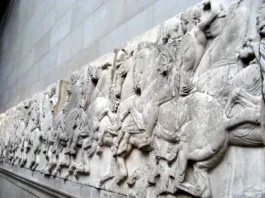The Mariana Trench is the deepest known oceanic trench on Earth, located in the western Pacific Ocean. It reaches a maximum depth of about 10,925 meters (35,843 feet) at its lowest point, known as the Challenger Deep, making it the deepest known point in the world’s oceans. The Mariana Trench is named after the nearby Mariana Islands.
Some key facts about the Mariana Trench include:
- Location: The Mariana Trench is located in the western Pacific Ocean, east of the Mariana Islands and north of Papua New Guinea. It is part of the Pacific Ring of Fire, a region known for its frequent earthquakes and volcanic activity due to the convergence of tectonic plates.
- Depth: The Challenger Deep, the deepest point within the Mariana Trench, reaches a maximum depth of about 10,925 meters (35,843 feet) below sea level. However, the exact depth may vary slightly as more accurate measurements are made through ongoing research and improved measurement techniques.
- Geology: The Mariana Trench is formed by the process of subduction, where the Pacific Plate is forced beneath the Mariana Plate, a process known as the Mariana Trench subduction zone. The intense pressure and friction between the plates cause the oceanic crust to bend and sink, creating the deep trench.
- Oceanic environment: The Mariana Trench is characterized by extreme environmental conditions, including high pressure, low temperatures, and darkness. These conditions create a unique and challenging environment that is home to a variety of specialized and unique species, some of which are found nowhere else on Earth. The study of the Mariana Trench provides valuable insights into deep-sea biodiversity, adaptations to extreme conditions, and the limits of life on Earth.
- Exploration: The Mariana Trench has been the subject of extensive scientific exploration using remotely operated vehicles (ROVs) and deep-sea submersibles. The first manned descent to the Challenger Deep was conducted by the bathyscaphe Trieste in 1960, and subsequent expeditions have continued to study the geology, biology, and ecology of the Mariana Trench.
- Environmental concerns: The Mariana Trench, like other oceanic trenches, is relatively remote and inaccessible, but it is not immune to human impacts. There are concerns about potential environmental impacts from activities such as deep-sea mining, pollution, and climate change on the delicate and unique ecosystems of the Mariana Trench. Responsible and sustainable management of this fragile environment is increasingly recognized as important.

Contents
Geographical and Physical Characteristics
The Mariana Trench is located in the western Pacific Ocean and is known for its unique geographical and physical characteristics. Here are some key details:
Geographical Characteristics:
- Location: The Mariana Trench is located in the western Pacific Ocean, east of the Mariana Islands and north of Papua New Guinea. It spans an area approximately 2,550 kilometers (1,580 miles) long and 69 kilometers (43 miles) wide at its widest point.
- Depth: The Challenger Deep, the deepest point within the Mariana Trench, reaches a maximum depth of about 10,925 meters (35,843 feet) below sea level, making it the deepest known point in the world’s oceans.
- Topography: The Mariana Trench is characterized by a V-shaped profile, with steep walls that descend sharply from the surrounding seabed to the Challenger Deep at its lowest point. The walls of the trench can reach heights of several kilometers and are studded with cliffs, ridges, and peaks.
Physical Characteristics:
- Pressure: The extreme depth of the Mariana Trench results in immense water pressure. At the bottom of the trench, the pressure can reach over 1,000 times the atmospheric pressure at sea level, equivalent to around 1,086 kilograms per square centimeter (15,329 pounds per square inch).
- Temperature: The water temperature in the Mariana Trench is generally near freezing, ranging from around 1 to 4 degrees Celsius (34 to 39 degrees Fahrenheit) due to the absence of sunlight and the influence of deep ocean currents.
- Ecology: Despite the extreme environmental conditions, the Mariana Trench is home to a diverse array of unique and adapted species. Deep-sea organisms in the Mariana Trench have developed various adaptations to survive in the high-pressure, low-temperature, and low-food environments, including bioluminescence, slow metabolic rates, and specialized feeding mechanisms.
- Seismic Activity: The Mariana Trench is located in the Pacific Ring of Fire, a region known for its frequent earthquakes and volcanic activity. The trench is associated with the Mariana Trench subduction zone, where the Pacific Plate is being forced beneath the Mariana Plate, leading to tectonic activity and the formation of earthquakes and volcanic features in the region.
These geographical and physical characteristics of the Mariana Trench make it a unique and fascinating area of study for geologists, marine biologists, and other scientists interested in understanding the mysteries of the deep ocean.

Unique geological and physical properties of the Mariana Trench
The Mariana Trench is known for its unique geological and physical properties, which set it apart from other oceanic trenches. Some of these properties include:
- Extreme Depth: The Mariana Trench is the deepest known point in the world’s oceans, with the Challenger Deep reaching a maximum depth of about 10,925 meters (35,843 feet) below sea level. This extreme depth creates an environment of immense pressure, with pressures exceeding 1,000 times the atmospheric pressure at sea level.
- Steep Walls: The walls of the Mariana Trench are incredibly steep, with cliffs, ridges, and peaks that can reach heights of several kilometers. The V-shaped profile of the trench creates a dramatic landscape that is distinct from other trenches.
- Tectonic Activity: The Mariana Trench is located in the Pacific Ring of Fire, a region known for its frequent earthquakes and volcanic activity. The trench is associated with the Mariana Trench subduction zone, where the Pacific Plate is being forced beneath the Mariana Plate, leading to tectonic activity and the formation of earthquakes and volcanic features in the region.
- Unique Sedimentation: The Mariana Trench exhibits unique sedimentation patterns due to its extreme depth and steep walls. The lack of sunlight and limited availability of organic material results in slow sedimentation rates, leading to the accumulation of fine-grained sediment and the preservation of ancient marine deposits.
- Extreme Environmental Conditions: The Mariana Trench is characterized by extreme environmental conditions, including high pressure, low temperatures, and darkness. These conditions create a challenging environment for life to thrive, and the organisms that do inhabit the trench have developed unique adaptations to survive in this harsh environment.
- Biodiversity: Despite the challenging environmental conditions, the Mariana Trench is home to a diverse array of unique and adapted species. Deep-sea organisms in the Mariana Trench have developed various adaptations to survive in the high-pressure, low-temperature, and low-food environments, including bioluminescence, slow metabolic rates, and specialized feeding mechanisms.
These unique geological and physical properties of the Mariana Trench make it a fascinating area of study for geologists, marine biologists, and other scientists interested in understanding the geology, ecology, and environmental conditions of the world’s deepest oceanic trench.
Marine Life in the Mariana Trench
The Mariana Trench, despite its extreme environmental conditions, is home to a diverse range of marine life. Although the extreme depths, high pressure, low temperatures, and darkness pose significant challenges to life, many organisms have adapted to thrive in this unique environment. Here are some key aspects of marine life in the Mariana Trench:
- Adaptations to High Pressure: Many organisms in the Mariana Trench have developed specialized adaptations to cope with the immense pressure. These adaptations include flexible bodies, reduced skeletal structures, and high-pressure enzymes that allow them to withstand the crushing pressure at the bottom of the trench.
- Bioluminescence: Bioluminescence, the ability to produce light, is common among many species in the Mariana Trench. Bioluminescent features are believed to serve a variety of functions, such as attracting prey, confusing predators, and communication in the dark depths where sunlight cannot penetrate.
- Slow Metabolic Rates: The lack of food and energy in the deep ocean environment has led to the evolution of slow metabolic rates in many species in the Mariana Trench. This allows them to conserve energy in the low-food environment and survive for long periods without food.
- Unique Feeding Mechanisms: Marine organisms in the Mariana Trench have evolved specialized feeding mechanisms to capture food in the pitch-black environment. Some species have long, slender bodies with large mouths and sharp teeth to capture prey, while others use bioluminescent lures or extendable jaws to catch food.
- Species Diversity: The Mariana Trench is home to a wide range of species, including various species of fish, crustaceans, cephalopods, and other invertebrates. Many of these species are found exclusively in the deep trenches and have unique adaptations to survive in this extreme environment.
- Potential for New Discoveries: Due to the extreme depths and remote location of the Mariana Trench, there is still much to learn about the marine life that inhabits this area. New species and previously unknown adaptations are continuously being discovered, making the Mariana Trench an area of ongoing scientific exploration and discovery.
The marine life in the Mariana Trench is a subject of fascination and research for marine biologists, ecologists, and other scientists, as it provides valuable insights into the adaptations and survival strategies of life in one of the most extreme and least explored environments on Earth.
Mariana Trench FAQ
Q: What is the Mariana Trench?
A: The Mariana Trench is the deepest known point in the world’s oceans, located in the western Pacific Ocean. It is a crescent-shaped trench that reaches a maximum depth of about 10,925 meters (35,843 feet) below sea level at its deepest point, known as the Challenger Deep.
Q: Where is the Mariana Trench located?
A: The Mariana Trench is located in the western Pacific Ocean, east of the Mariana Islands and near the Mariana Trench subduction zone. It spans an area between Japan to the north and Papua New Guinea to the south.
Q: How deep is the Mariana Trench?
A: The Mariana Trench reaches a maximum depth of about 10,925 meters (35,843 feet) at its deepest point, known as the Challenger Deep. This makes it the deepest known point in the world’s oceans.
Q: What are some unique features of the Mariana Trench?
A: The Mariana Trench is known for its extreme depth, reaching the deepest point in the world’s oceans. It also has steep walls, tectonic activity associated with the Mariana Trench subduction zone, unique sedimentation patterns, extreme environmental conditions, and diverse marine life with unique adaptations.
Q: What is the temperature and pressure like in the Mariana Trench?
A: The temperature in the Mariana Trench varies depending on the depth, but it generally ranges from about 1 to 4 degrees Celsius (34 to 39 degrees Fahrenheit). The pressure at the bottom of the trench can exceed 1,000 times the atmospheric pressure at sea level, reaching extreme levels of over 1,086 bar (15,750 psi).
Q: What is the significance of the Mariana Trench in scientific research?
A: The Mariana Trench is a significant area for scientific research due to its unique geological and physical properties, extreme environmental conditions, and diverse marine life. It provides valuable insights into deep-sea ecology, geology, biogeography, adaptation to extreme environments, and other scientific fields.
Q: Are there any human activities in the Mariana Trench?
A: As of current knowledge cutoff (September 2021), there have been limited human activities in the Mariana Trench due to its extreme depth and challenging environment. However, there have been deep-sea exploration missions, scientific expeditions, and some deep-sea technological testing in the region. There are ongoing discussions and debates about potential future human activities, such as deep-sea mining and its potential impacts on the Mariana Trench ecosystem.
Q: What are the threats to the Mariana Trench ecosystem?
A: The Mariana Trench ecosystem faces potential threats from human activities such as deep-sea mining, pollution, climate change, and habitat destruction. These activities may have direct or indirect impacts on the unique and fragile ecosystem of the Mariana Trench, and the potential consequences of these threats are still being studied.
Q: What are some recent discoveries in the Mariana Trench?
A: The Mariana Trench is a subject of ongoing scientific exploration, and new discoveries are continuously being made. Some recent discoveries include new species of deep-sea organisms, novel adaptations to extreme conditions, unique geological features, and insights into the biogeography and ecology of the trench. Scientific research in the Mariana Trench is an active and evolving field, and new findings are regularly published in scientific journals.
Q: Can humans survive in the Mariana Trench?
A: Due to its extreme depth, high pressure, low temperatures, and other challenging environmental conditions, the Mariana Trench is not a suitable environment for human survival without specialized equipment and technology.
 English
English Español
Español Français
Français Deutsch
Deutsch Italiano
Italiano Português
Português Türkçe
Türkçe Nederlands
Nederlands Русский
Русский 한국어
한국어 Čeština
Čeština Polski
Polski Ελληνικά
Ελληνικά 简体中文
简体中文





